ZB vz. 26
The ZB vz. 26 was a Czechoslovak light machine gun developed in the 1920s, which went on to enter service with several countries. It saw its major use during World War II, and spawned the related ZB vz. 27, vz. 30, and vz. 33. The ZB vz. 26 influenced many other light machine gun designs including the British Bren light machine gun and the Japanese Type 96 Light Machine Gun. The ZB-26 is famous for its reliability, simple components, quick-change barrel and ease of manufacturing. This light machine gun in the Czechoslovak army was marked as the LK vz. 26 ("LK" means lehký kulomet, light machine gun; "vz." stands for vzor, Model in Czech). ZB vz. 26 is incorrect nomenclature because "ZB-26" is a factory designation (Československá zbrojovka v Brně), while "vzor 26" or "vz. 26" is an army designation.
| Vz. 26 | |
|---|---|
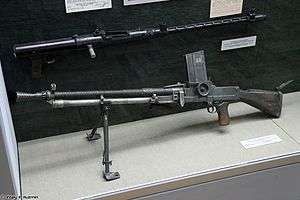 vz. 26 at the Great Patriotic War Museum, Smolensk | |
| Type | Light machine gun |
| Place of origin | Czechoslovakia |
| Service history | |
| In service | 1926-present |
| Used by | See Users |
| Wars | Second Sino-Japanese War Chaco War Spanish Civil War Second Italo-Ethiopian War Dersim rebellion World War II Ecuadorian–Peruvian War[1] Chinese Civil War Korean War Indochina War Vietnam War Laotian Civil War Biafran war Insurgency in Aceh[2] Soviet–Afghan War Yugoslav Wars[3] |
| Production history | |
| Designer | Václav Holek |
| Designed | 1924 |
| Manufacturer | Zbrojovka Brno, Military Technical Institute Kragujevac[4] |
| Produced | 1924–1953 |
| Variants | See Variants |
| Specifications | |
| Mass | 9.65 kg (21.27 lb)[5] |
| Length | 1,161 mm (45.7 in)[5] |
| Barrel length | 672 mm (26.5 in)[5] |
| Cartridge | 7.92×57mm Mauser |
| Action | Gas-operated, tilting breechblock |
| Rate of fire | 500 rounds/min[5] |
| Muzzle velocity | 764 m/s (2,507 ft/s)[5] |
| Effective firing range | 1,000 m (1,100 yd) |
| Feed system | 20- or 30-round detachable box magazine[5] |
| Sights | Front blade, rear leaf sight |
Development
In around 1921 the military of the young Czechoslovakian state embarked on a quest for a light machine gun of their own. Early trials included foreign designs such as Berthier, M1918 Browning automatic rifle, Darne machine gun, Hotchkiss M1914 machine gun, Madsen machine gun, St. Étienne Mle 1907, and several domestic designs. Of these, the most important was the Praha II, a lightweight, belt-fed weapon built at Česka Zbrojovka (CZ) Praha (Czech Arms factory in Prague).
Development of the ZB-26 began in 1923 after the Czechoslovak Brno arms factory was built. Since CZ-Praha was a relatively small factory with limited industrial capabilities, it was decided to transfer the production of the new automatic weapon to the more advanced Zbrojovka Brno, or ZB in short. This transfer resulted in a long series of court trials over royalties, between the owners of the design (CZ-Praha) and the manufacturer (ZB). Designer Václav Holek was charged by the Czechoslovak army with producing a new light machine gun. He was assisted by his brother Emmanuel, as well as two Austrian and Polish engineers, respectivily named Marek and Podrabsky.[6] Holek quickly began work on the prototype of the Praha II and within a year the quartet had created an automatic light machine gun that was later known as the ZB.
Before long, the Holek brothers abandoned the belt feed in favor of a top-feeding box magazine and the resulting weapon, known as the Praha I-23, was selected. Despite the past legal troubles, manufacture of the new weapon had commenced at the ZB factory by late 1926, and it became the standard light machine gun of the Czechoslovak Army by 1928.
Design
The ZB-26 is a gas-operated, air-cooled, selective-fire machine gun. It has a finned, quick-detachable barrel and fires from an open bolt. Its action is powered by a long-stroke gas piston, located below the barrel. The gas block is mounted at the muzzle end of the barrel and also serves as the front sight base. The action is locked by tipping the rear of the bolt (breechblock) upwards, and into a locking recess in the receiver. The return spring is located in the butt of the weapon, and is connected to the bolt carrier/gas piston via a long rod; additionally, there is a short spring buffer located around the return spring at the juncture of the receiver and butt, which softens the impact of the bolt group at the end of its rearward stroke.
Its charging handle is located at the right side of receiver and does not reciprocate when the gun is fired. The ammunition feed is from a top-mounted box magazine made from sheet steel, holding just 20 rounds in a two-row configuration. The magazine housing has a forward-sliding dust cover. Spent cartridges are ejected downwards. The ejection port is normally closed with its own dust cover which opens automatically once the trigger is pressed. The trigger unit permits both single shots and automatic fire, selectable through a safety/fire mode selector lever situated at the left side of the pistol grip. The gun fires from an open bolt and the spring-loaded firing pin is operated by a projection on the bolt carrier, once the bolt is fully in battery and locked. Because of the overhead magazine, the sight line is offset to the left, and the front sight is mounted on a base which protrudes upward and to the left from the gas block.
The rear sight is attached to the left side of receiver, and has a range adjustment mechanism controlled by a knurled rotating knob. Standard furniture consists of an integral folding bipod, which is attached to the gas cylinder tube, and a wooden butt with a spring-buffered buttplate and a folding shoulder rest plate. Although the ZB-26 was intended for the light machine gun role, it was also offered with a sustained-fire tripod, and provided with a sufficient supply of full magazines and spare barrels it could serve (to some extent) as a medium machine gun. The same tripod was also adaptable for the anti-aircraft role.
Deployment and service
The ZB-26 saw service with the Czechoslovak infantry from 1928, as well as being the primary or secondary armament on many later model Škoda armored vehicles. 45,132 were bought by Czechoslavakia during the interwar.[7] It is believed that the ZB factory turned more than 120,000 ZB-26 guns between 1926 and 1939 in a variety of calibers (the most popular being its original 7.92×57mm Mauser). It was exported to twenty-four European, South American and Asian countries, both in its original form and in the slightly improved ZB-30 version. Large batches of ZB light machine guns went to Bolivia, Bulgaria, China, Romania, Turkey and Yugoslavia. Lithuania and Yugoslavia were the first users to adopt the gun, before the Czechoslovak Army.[7] Exports continued until 1939, when Nazi Germany under Adolf Hitler took over Czechoslovakia. More were produced for export than for the Czechoslovak Army[8] 7,136 ZB-26 were produced in Czechoslovakia after the war, from 1945 to 1953.[7]
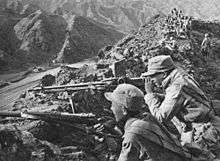
The Wehrmacht soon adopted the ZB-26 after the occupation of Czechoslovakia, renaming it the MG 26(t);[9] it was used in the same role as the MG 34, as a light machine gun. In the opening phases of World War II, the ZB-26 in 7.92mm Mauser caliber was used in large numbers by elements of the German Waffen-SS, who at first did not have full access to standard Wehrmacht supply channels. In its most famous incarnation, the ZB-26 was modified by ZB and British technicians, entering service as the famous Bren gun.[10] Many more countries imported or produced the design under license, including China and Yugoslavia. Chinese Nationalist forces used the ZB-26 chambered for the 7.92×57mm Mauser round in their struggle with Communist Chinese and later Imperial Japanese forces. Likewise, the Chinese Red Army (as with any other captured weapon) turned the Nationalists' ZB-26 machine guns against them and the Japanese. According to Brno, from 1927 to 1939, a total of 30,249 ZB-26 were exported to China.[7] Various Chinese pro-Japanese forces, such as the Collaborationist Chinese Army[11] or the Inner Mongolian Army, used it.[12] During this time due to high demand, Chinese small-arms factories—state-owned as well as those controlled by various warlords—were producing the ZB-26. During the Korean War, Chinese Communist forces employed the ZB-26 against UN forces, and PVA ZB gunners developed a well-deserved reputation for long-range marksmanship. During the First Indochina War with French and later South Vietnamese forces, the ZB-26 was found in the hands of both North Vietnamese Army and Viet Minh guerrillas.[13]
Variants
- ZB vz. 24: the weapon's predecessor.[7]
- ZB vz. 27: later variant, proposed to Portugal and United Kingdom.[14]
- ZB vz. 30: later variant.
- ZGB 30: final modifications to the vz. 30 for British trials.
- ZGB 33: in its final form was virtually identical to the British Bren light machine gun.
- ZB 39: commercial variant similar to the Bren, chambered in various different rounds and having different sights, among other minor changes.[15]
- ZB vz. 52 : post-war derivative of the ZB vz. 26.
- The Japanese Type 97 heavy tank machine gun was a license built copy of the ZB-26 and intended for use in Japanese tanks. It was not normally issued as an infantry light machine gun. Other than the cocking handle being moved from the right side of the receiver to the left it is essentially a duplicate of the Czech gun in operation.
- The Spanish Fusil ametrallador Oviedo was a post-war clone of the ZB vz.26/30.
More designations appear depending on the adopting army, though generally the gun retains its 'ZB 26' initials in one form or another.
Users
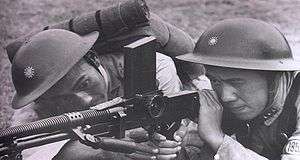





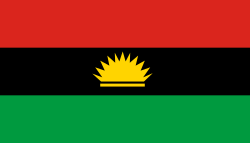



.svg.png)

.svg.png)
.svg.png)
.svg.png)
.svg.png)

.svg.png)
.svg.png)
.svg.png)



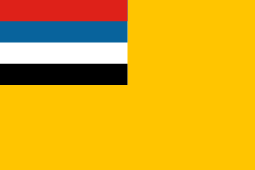
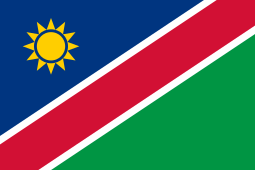

.svg.png)


.svg.png)




.svg.png)
.svg.png)
See also
- Bren Gun - British .303 design
- FM-24/29 light machine gun
- Lahti-Saloranta M/26
- Madsen machine gun
- Mendoza RM2
- Type 96 light machine gun - influenced by ZB vz. 26 design
- Type 97 heavy tank machine gun - license-built loading 7.7x58mm Arisaka ammunition
- Type 99 light machine gun - follow on to the Type 96
References
- Jowett, Philip (28 June 2018). Latin American Wars 1900–1941: "Banana Wars," Border Wars & Revolutions. Men-at-Arms 519. Osprey Publishing. p. 39. ISBN 9781472826282.
- Davies, Matt (27 September 2006) [1970]. Indonesia's War over Aceh: Last Stand on Mecca's Porch (eBook ed.). London: Routledge. p. 32. doi:10.4324/9780203968802. ISBN 9781134193318.
- The Defense Of Bosnia. Studio "FLASH" Sarajevo. April 1999. Event occurs at 45:53. Retrieved 22 May 2015.
- http://www.zastava-arms.rs/sr/imagetext/1919-1941
- "Fusils-mitrailleurs Lehky Kulomet ZB vz.26 and vz.30". Encyclopédie des armes : Les forces armées du monde (in French). II. Atlas. 1984. p. 262.
- Smith, Joseph E. (1969). Small Arms of the World (11 ed.). Harrisburg, Pennsylvania: The Stackpole Company. p. 125.CS1 maint: ref=harv (link)
- "Lehký kulomet ZB 26" [Light machine gun ZB 26]. vhu.cz (in Czech). Vojenský historický ústav Praha.
- Grant, Neil (2013). The Bren Gun. Weapon 22. Osprey Publishing. p. 10. ISBN 978-1782000822.
- The Encyclopedia of Weapons of World War II by Chris Bishop, page 237.
- Skřivan, Aleš (2010). "On the Nature and Role of Arms Production in Interwar Czechoslovakia" (PDF). The Journal of Slavic Military Studies. 23 (4): 630–640. doi:10.1080/13518046.2010.525488. Archived from the original (PDF) on 3 March 2017.
- Jowett 2004, pp. 46,71.
- Jowett 2004, pp. 51,56.
- Windrow, Martin (20 September 2018). French Foreign Légionnaire vs Viet Minh Insurgent: North Vietnam 1948–52. Combat 36. Osprey Publishing. pp. 24–25. ISBN 9781472828910.
- "Čs. lehký kulomet ZB vz. 27" [Czech light machine gun ZB vz. 27]. vhu.cz (in Czech). Vojenský historický ústav Praha.
- "ZB 39". iwm.org.uk. Imperial War Museum.
- Bhatia, Michael Vinai; Sedra, Mark (May 2008). Small Arms Survey (ed.). Afghanistan, Arms and Conflict: Armed Groups, Disarmament and Security in a Post-War Society. Routledge. p. 65. ISBN 978-0-415-45308-0.CS1 maint: ref=harv (link)
- "WWII gear in Afghan use: Part I – Firearms". wwiiafterwwii.wordpress.com. 1 June 2015. Retrieved 10 April 2018.
- Grant 2013, p. 65.
- Fencl, Jiří (1991). "Nejprodávanější československá zbraň" (in Czech). Militaria, Elka Press. Retrieved 12 March 2019.
- Jowett, Philip (2016). Modern African Wars (5): The Nigerian-Biafran War 1967-70. Oxford: Osprey Publishing Press. p. 23. ISBN 978-1472816092.
- Jowett, Philip. The Chinese Army 1937-49: World War II and Civil War. Osprey Publishing. p. 44. ISBN 1-84176-904-5.
- http://www.sadefensejournal.com/wp/?p=2406
- Smith 1969, pp. 295-296.
- http://www.chinaww2.com/2014/09/27/favorite-machine-gun/
- Gun Digest Book of Cz Firearms by Robb Manning, page 22.
- "Zarumilla War 1941: Ecuadorian-Peruvian War of 1941". globalsecurity.org. Retrieved 2 February 2019.
- Smith 1969, p. 320.
- Smith 1969, p. 498.
- "North Korean Small Arms (Democratic People's Republic of Korea)". Small Arms Review. Vol. 16 no. 2. June 2012.
- Jowett, Philip S. (2004). Rays of the Rising Sun: Armed Forces of Japan's Asian Allies 1931-45: Volume 1: China and Manchukuo. Helion & Company Limited. p. 32.CS1 maint: ref=harv (link)
- "Their Blood Waters our Freedom". Youtube.com. 25 January 2020. Retrieved 19 May 2020.
- Malmassari, Paul (2016). "Slovak Republic". Armoured Trains. Seaforth Publishing. p. 415. ISBN 9781848322653. Retrieved 30 March 2019.
- Smith 1969, p. 547.
- Janson, O. (23 October 2017). "The Light Machine Guns of Sweden". gotavapen.se. Archived from the original on 1 December 2017.
- Smith 1969, p. 570.
- Chris Bishop (1996). Vital Guide to Combat Guns and Infantry Weapons. p. 203. ISBN 1853105392.
- Smith 1969, p. 719.
- Vukšić, Velimir (July 2003). Tito's partisans 1941–45. Warrior 73. Osprey Publishing. p. 25. ISBN 978-1-84176-675-1.
External links
| Wikimedia Commons has media related to ZB 26. |